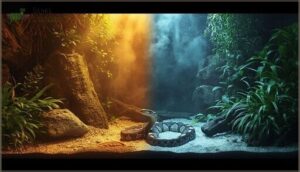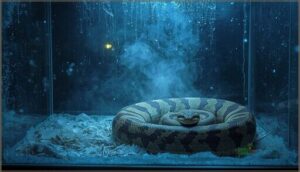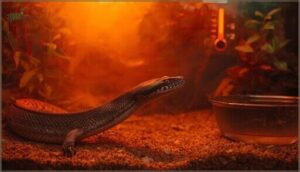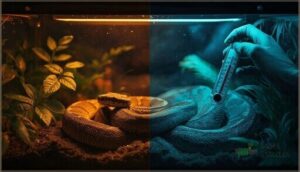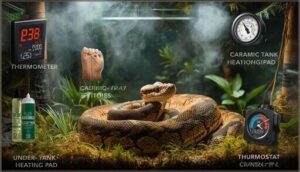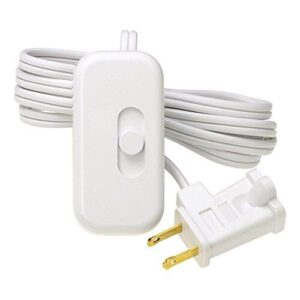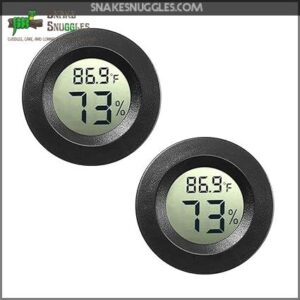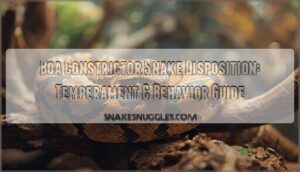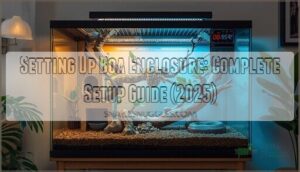This site is supported by our readers. We may earn a commission, at no cost to you, if you purchase through links.
Your boa constrictor can’t shiver to warm up or sweat to cool down. When temperatures drop below 30°F or climb above 100°F, its body simply shuts down.
These extremes don’t just cause discomfort—they trigger hypothermia or heat stroke that can kill within hours. Even brief exposure to lethal temperatures causes organ failure, dehydration, and metabolic collapse.
The challenge isn’t just avoiding these deadly extremes. You need to understand the safe temperature range your boa requires, recognize early warning signs of temperature stress, and know exactly how to respond when things go wrong.
Table Of Contents
- Key Takeaways
- What Temperature Will Kill a Boa Constrictor
- Boa Constrictor Temperature Requirements
- Dangers of Extreme Cold for Boa Constrictors
- Risks of Excessive Heat in Boa Constrictors
- Factors Affecting Boa Constrictor Temperature Tolerance
- Preventing Fatal Temperature Extremes
- Emergency Steps for Temperature-Stressed Boas
- Top 5 Products for Boa Constrictor Temperature Control
- Frequently Asked Questions (FAQs)
- Can boa constrictors eat cold weather?
- What temperature does a boa constrictor need?
- Can boas be constricted?
- How many hours of daylight should a boa constrictor have in summer?
- Do Boa Constrictors use hot spots?
- Where do boa constrictors live?
- What happens if a boa constrictor is too cold?
- How do you keep a boa constrictor warm?
- Do boa constrictors need a thermostat?
- How cold is too cold for a boa constrictor?
- Conclusion
Key Takeaways
- Boa constrictors can quickly die if exposed to temperatures below 30°F or above 100°F, as their bodies can’t regulate heat internally.
- A safe and healthy range for your boa’s enclosure is 80–85°F for ambient air, with a basking spot of 88–92°F and night temperatures never dropping below 70°F.
- Sudden or prolonged exposure to extreme cold or heat can cause organ failure, metabolic collapse, and death within hours.
- Using thermostats, digital thermometers, and proper insulation is essential to maintain stable, safe temperatures and prevent fatal accidents.
What Temperature Will Kill a Boa Constrictor
If you’re wondering just how cold or hot is too much for a boa constrictor, you’re not alone. These snakes have very real limits with respect to temperature.
Let’s look at what actually puts them at risk.
Critical Low Temperature Threshold
On a cold night or during a power outage, the mortality risk for boa constrictors climbs sharply if temperatures dip below 30°F. Hypothermia onset is rapid at these levels, and even brief exposure can overwhelm their natural acclimation.
Enclosure studies and veterinary guidelines stress that cold temperature effects on boas—like sluggishness or failure to feed—signal real risks of cold exposure.
Students explore similar biotechnology design themes in academic competitions.
Lethal High Temperature Range
Too much heat quickly turns deadly for boa constrictors. Once temperatures push above 100°F, your snake can go from heat stress to organ failure fast—especially if there are no cooler refuges or hydration options in the enclosure. Even short bursts above 104°F greatly increase Mortality Risk, making controlled reptile health management essential for snake health.
For boa constrictors, temperatures above 100°F trigger rapid organ failure, and exposure beyond 104°F can quickly prove fatal
Addressing climate change issues is key for maintaining stable environments for reptiles.
Duration of Exposure and Mortality Risk
Exposure time is as important as the temperature itself. A boa can survive short periods just under its usual range, but lingering below those temperature thresholds—especially with added dehydration—pushes mortality factors way up.
Even a few hours near 50°F risks hypothermia or tissue damage. Sometimes cooling is recoverable, but with severe heat stress, death can follow swiftly.
Boa Constrictor Temperature Requirements
To keep a boa constrictor healthy, you need to pay close attention to temperature. The right setup lets your snake warm up, cool down, and control its comfort.
Here are some popular ways to create the right environment.
Optimal Temperature Range for Survival
Think of your boa constrictor’s enclosure like a climate puzzle: every piece matters for survival. Aim for an ideal ambient temperature between 80–85°F where a healthy temperature range is closely regulated.
The basking site temperature should reach 84–90°F, ensuring proper temperature regulation and preventing hypothermia. A well-planned temperature gradient meets your boa constrictor’s needs for peak health.
Nighttime Temperature Drops
As night falls, a sudden drop in temperature can spell trouble for your boa constrictor. Rapid temperature fluctuations lead to metabolic stress, bradycardia risk, and cold spots that jeopardize reptile health.
Even a brief chill may spark respiratory issues or shedding problems. Insulating the enclosure and watching for hypothermia signs keeps your snake safe from harm.
Importance of a Temperature Gradient
Thermoregulation benefits are the unsung heroes in any boa constrictor enclosure. A temperature gradient lets your snake choose its ideal comfort zone, boosting digestion and reducing stress. Seasonal adaptation mimics nature, but failing to provide a proper gradient can risk hypothermia or overheating.
- Promotes healthy digestion
- Prevents thermal burns
- Reduces stress and illness
- Fosters natural behaviors
- Allows safer seasonal cycling
Dangers of Extreme Cold for Boa Constrictors
Cold temperatures can quickly become life-threatening for boa constrictors. It’s important to know what happens when they’re exposed to more chill than they can handle.
Let’s look at some options to help your snake stay safe when the weather turns cold.
Hypothermia Symptoms and Progression
Even a brief brush with cold temperatures can spell trouble for your boa. Hypothermia first dulls motor function—your snake may seem clumsy or confused.
As body temperature drops, a falling metabolic rate slows everything from breathing to heartbeat. Severe hypothermia risks cardiac arrest.
Be careful: quick rewarming may harm reptile health, so always warm gradually for your boa’s wellbeing.
Effects of Temperatures Below 30°F (-1°C)
When temperatures below 30 degrees Fahrenheit hit, your boa faces serious mortality risk. Cold shock dramatically reduces metabolic rate and heart function, while tissue necrosis threatens within hours:
- Impaired digestion and sluggish metabolism strike within 24 hours
- Cold shock drops heart rate by 15–25% in just six hours
- Tissue damage and peripheral necrosis develop as cells freeze
Recovery times often exceed 48 hours after brief cold exposure.
Long-term Consequences of Cold Exposure
Repeated cold stress doesn’t just fade away—it triggers metabolic disruption that slows your boa’s growth and feeding responses by 15–25%. Immune suppression follows, opening the door to infections your snake could normally fight off.
Over time, tissue damage in key organs and respiratory issues compound, potentially cutting your boa’s lifespan by 10–20%.
| Cold Exposure Effect | Impact on Your Boa |
|---|---|
| Metabolic Disruption | Stunted growth, delayed shedding |
| Immune Suppression | 15–25% higher infection rates |
| Behavioral Changes | Reduced appetite, sluggish activity |
| Tissue Damage | Kidney and liver harm |
| Lifespan Reduction | 10–20% shorter life expectancy |
Risks of Excessive Heat in Boa Constrictors
While cold temperatures get most of the attention, excessive heat can kill your boa just as quickly—and sometimes faster. Heat stress damages organs in ways that aren’t always obvious until it’s too late.
Here’s what happens when your boa gets too hot and how to spot the danger before it becomes fatal.
Signs of Overheating and Heat Stress
When your boa can’t escape the heat, you’ll notice panting or open-mouth breathing—clear distress signals. Lethargy sets in as your snake struggles to cope with rising temperatures. Between 30–35°C (86–95°F), these behaviors often appear before more serious health problems develop.
Watch for your boa seeking cooler spots constantly. Dehydration accelerates quickly, increasing the risk of organ failure and heatstroke if you don’t intervene.
Lethal Upper Temperature Limits
At 40°C (104°F) or higher, your boa faces serious danger. Prolonged heat above this threshold triggers fatal heatstroke within 2–4 hours, especially if dehydration sets in. Core temperatures hitting 41–42°C cause rapid organ dysfunction and oxidative stress throughout the body.
Even six hours above 40°C raises mortality risk by 40% in adults—heat stress signs demand immediate action to prevent irreversible health problems.
Dehydration and Organ Failure Risks
Heat stress doesn’t kill alone—dehydration accelerates organ failure. When your boa lacks water access during heat exposure, renal perfusion drops sharply, spiking blood urea nitrogen and creatinine levels. Electrolyte imbalance follows, especially hypernatremia, which disrupts neuromuscular function.
Noticeable rehydration and temperature correction improve outcomes in organ distress cases, so monitor water availability closely to protect your snake’s health and wellbeing.
Factors Affecting Boa Constrictor Temperature Tolerance
Not all boa constrictors handle temperature changes the same way. Your snake’s ability to react to heat and cold depends on its unique characteristics and background.
Let’s look at the key factors that influence how your boa reacts to temperature extremes.
Species and Subspecies Variations
Not all boas respond to heat the same way. Lineage thermal tolerance varies across subspecies, meaning your snake’s geographic origin affects how it tolerates cold and warmth. Here’s what you need to know:
- Subspecies temperature bands can shift by 2–4°C between populations.
- Central American boas may tolerate nighttime cooling differently than South American varieties.
- Acclimation rate variations depend on your boa’s genetic background.
- Captive care sheets often provide subspecies-specific temperature guidelines.
- Thermal tolerance reflects adaptations from each boa constrictor’s native habitat.
Age, Size, and Health Considerations
Your snake’s life stage affects how it responds to temperature swings. Juvenile temperatures run 2–3°C warmer to fuel growth and metabolic processes, while adults thrive near 26–30°C.
Size tolerance drops in larger boas—they heat and cool slower, raising heat stress risk.
Health sensitivity spikes if your snake’s sick: infections or organ issues slash temperature tolerance, triggering immune system strain within hours.
Adaptations From Natural Habitat
In their natural habitat, boa constrictors evolved as ectothermic hunters relying on habitat adaptation to survive. Your snake needs specific microhabitat needs mirrored from tropical origins:
- Thermal gradient from 78–88°F ambient to 88–92°F basking spots aids digestion
- Humidity levels around 60–80% prevent shedding problems
- Diel cycles with nighttime drops to 72–78°F reduce stress
- Regional variances exist, but all boas thrive with consistent temperature zones
Preventing Fatal Temperature Extremes
Keeping your boa constrictor alive means getting the enclosure right from the start. You can’t just guess at temperatures and hope for the best—you need the right setup, consistent monitoring, and fail-safes in place.
Here’s how to create an environment that protects your snake from deadly temperature swings.
Proper Enclosure Setup and Insulation
Think of your reptile enclosure as a climate-controlled fortress. Proper insulation materials—like foam board on three sides—keep external temperature swings from destabilizing your setup.
Choose reflective basking surfaces to concentrate heat where your boa needs it most. Install your thermostat probe near the basking zone, not directly under lamps.
Calibrate monitoring equipment regularly so you’re tracking accurate data, not guesswork.
Creating and Maintaining a Temperature Gradient
To help your boa constrictor regulate its body temperature, position your heat source on one end of the enclosure to create a warm basking zone around 88–92°F and a cooler retreat at 78–82°F. This microclimate variety lets your snake shift as needed.
Keep nighttime reduction modest—just 5–10°F lower. A gradient span of 6–12 inches works well for most adults.
Using Thermostats and Monitoring Devices
Manual temperature checks can’t catch the sudden swings that kill boas, so active monitoring is essential for safety.
- Thermostat calibration — Set your thermostat to regulate heating elements within ±1°F, preventing deadly spikes above 104°F or drops below 70°F.
- Accurate monitoring — Use a digital thermometer and infrared temperature gun to verify gradient control across warm and cool zones.
- Backup systems — Install remote monitoring with alerts to catch equipment failures before temperature fluctuations turn fatal.
Emergency Steps for Temperature-Stressed Boas
When your boa’s temperature swings too far in either direction, you need to act fast but carefully. Rushing the process can cause more harm than the temperature problem itself.
Here’s how to safely bring your snake back to a healthy range and recognize when professional help is necessary.
Safely Warming a Cold Boa Constrictor
When your boa is too cold, gradual warming is essential to prevent shock. Move your snake to a room near 80°F and provide a gentle heat source, like a heating pad set on low.
Monitor behavior closely—if your boa stays lethargic or won’t respond after several hours, seek veterinary guidance immediately. Offer water to support hydration, and remember: slow, steady temperature adjustments are key to safe reptile care and long-term recovery.
Cooling an Overheated Boa Constrictor
If your boa is overheating, immediate cooling to 85–90°F can reverse most heat-stress symptoms within 24 hours. Move your snake to a cooler space and provide fresh water for rehydration methods that restore electrolyte balance.
Watch for elevated panting rates—these signal severe distress. Gradual temperature drops prevent shock, and proper snake care means never rushing the cooling process in reptile care emergencies.
Monitoring Recovery and When to Seek Veterinary Care
After cooling or warming your boa constrictor, watch for hypoxia signs like labored breathing or weakness. Early intervention matters—65% of temperature-stressed boas show distress within 24 hours.
Use a thermometer with ±0.5°C accuracy to track recovery. If lethargy persists beyond 72 hours, veterinary evaluation reduces hospital stays and lowers mortality rates above 30% in severe cases.
Top 5 Products for Boa Constrictor Temperature Control
You can’t control your boa’s temperature without the right tools. The products below help you monitor heat levels, prevent dangerous fluctuations, and create the stable environment your snake needs to thrive. Each one tackles a specific challenge in temperature management.
1. Reptile Heat Lamp Anti Scald Guard
 View On Amazon
View On Amazon You’ll want a heat lamp guard to protect your boa from accidental contact burns. Studies show guarded heat sources cut burn incidents from 12 to just 3 per 100 reptiles over six months. Position the guard 5–10 cm around your basking area to maintain effective temperature while keeping your snake safe.
This simple addition reduces keeper injuries by roughly 44% in mixed-age households. It’s a straightforward upgrade that improves compliance and safety in any reptile enclosure without compromising your heat source’s performance.
Best For: Reptile owners who want to prevent contact burns while maintaining a safe basking temperature for their boas, bearded dragons, or other heat-loving reptiles.
- Cuts burn incidents dramatically—from 12 down to 3 per 100 reptiles over six months, based on controlled studies.
- Heavy metal construction with efficient heat dissipation keeps temperatures effective while protecting your pet from direct lamp contact.
- Quick-access door and easy screw installation make bulb changes simple, and it fits most standard E26 bulbs up to 5.3 inches in diameter.
- Won’t accommodate oversized bulbs—limited to those under 6.5 inches tall and 5.3 inches wide.
- Included screws may be too small for certain enclosure materials, so you might need to grab replacements.
- At 5.5 inches wide, it may feel bulky in smaller or more compact reptile setups.
2. Lutron Plug In Lamp Dimmer
A plug-in dimmer gives you fine control over your heat lamp’s intensity without rewiring your setup. The Lutron model cuts energy savings by reducing bulb output when full heat isn’t needed, though bulb compatibility issues can arise with non-dimmable LEDs.
You’ll notice some dimmer heat output and a faint dimmer buzzing sound on low settings, but installation ease makes it ideal for adjusting basking zones.
Slide it down at night to match your boa’s cooler temperature needs, then dial it back up for daytime warmth.
Best For: Boa keepers who want precise control over heat lamp intensity to maintain safe temperature gradients without rewiring their enclosure setup.
- Simple plug-and-play installation lets you adjust basking temperatures instantly with a slide control, making it easy to fine-tune your boa’s thermal gradient throughout the day.
- Reduces energy costs by dimming bulbs when full heat isn’t necessary, which also extends bulb life and cuts down on replacement frequency.
- Six-foot cord gives you flexibility in lamp placement while maintaining easy access to temperature adjustments for daily and nighttime cycles.
- Only compatible with incandescent and halogen bulbs, so you can’t use it with many modern heat lamp options or non-dimmable LEDs.
- Can produce a noticeable buzz or flicker on the lowest settings, which may be distracting in quiet rooms like bedrooms or nurseries.
- Gets warm to the touch during extended use, and the 2-prong design lacks grounding that some users prefer for added safety with heating equipment.
3. Etekcity Infrared Laser Temperature Thermometer Gun
Checking your boa’s basking spot with an infrared thermometer gun delivers instant readings from 14 inches away—no guessing games. The Etekcity model’s 12:1 Distance Ratio lets you measure tight corners without disturbing your snake, while adjustable Emissivity Settings account for different Target Surfaces like wood or ceramic.
You’ll get accurate temps in half a second, though Accuracy Calibration matters for glass or reflective areas. Battery Life spans months with typical use, making temperature regulation in snakes straightforward and keeping your boa’s environmental temperature requirements on track.
Best For: Snake owners who need quick, non-contact temperature checks across multiple zones in their boa’s enclosure without disturbing the animal.
- Half-second response time means you can scan basking spots, cool zones, and substrate temps in seconds without waiting around
- The 12:1 distance ratio lets you measure hard-to-reach corners or elevated perches from 14 inches away, keeping your hands out of the enclosure
- Adjustable emissivity settings give you accurate readings on different surfaces like ceramic heat emitters, wood hides, or glass walls
- Doesn’t store temperature readings, so you’ll need to write down measurements or remember them for tracking trends over time
- Reflective surfaces like glass can throw off accuracy unless you adjust emissivity settings correctly—adds an extra step
- Battery-powered design means you’ll need to keep AAA batteries on hand, and they can die at inconvenient times
4. Digital Indoor Outdoor Hygrometer Thermometer
A hygrometer thermometer with an LCD Display tracks both temperature and humidity levels in your boa’s enclosure—two factors that work together for proper temperature control. The JEDEW unit updates readings every 10 seconds, giving you reliable Temperature Accuracy across a 32°F to 158°F range while Humidity Monitoring spans 10% to 99% RH.
Battery Life lasts up to 10 months on one LR44 cell, and compact Placement Options let you mount it anywhere. You’ll spot problems before they threaten your snake’s health.
Best For: Boa owners who need reliable real-time monitoring of both temperature and humidity to catch dangerous fluctuations before they cause stress or mortality.
- Updates every 10 seconds so you’ll spot sudden temperature drops below 70°F or spikes above 90°F before they become life-threatening to your boa.
- Wide range covers the full safe zone for boas (70°F to 90°F) and alerts you to lethal extremes, with Fahrenheit/Celsius switching built in.
- 10-month battery life means you won’t lose monitoring during critical periods, and the compact size fits any enclosure setup.
- Double-sided tape may fail in high-humidity enclosures, requiring alternative mounting solutions.
- Display isn’t backlit, so checking readings in dim conditions or at night can be difficult.
- Some units show minor reading discrepancies, which matters when you’re tracking narrow safe temperature ranges for reptiles.
5. Kandinsky And The Russian House
Kandinskys Inspiration and Russian Art hold no place in reptile care, despite this listing’s odd placement. The book explores Cultural Influence and Artistic Evolution through Historical Context—fascinating for art students, but it won’t help your boa constrictor survive temperature extremes.
You need equipment that monitors snake survival conditions and reptile health, not cultural history. Skip this $22 purchase when shopping for temperature control tools.
Focus your budget on devices that actually regulate your enclosure’s thermal gradient and protect your snake from lethal heat or cold.
Best For: Art history enthusiasts and students interested in Kandinsky’s cultural roots and the influence of Russian heritage on his pioneering abstract work.
- Offers detailed insight into the connection between Kandinsky’s artistic vision and the Russian House, enriching understanding of his creative evolution.
- Priced affordably at $22, making it accessible for students and casual readers exploring Russian art history.
- Provides historical context that bridges cultural studies and modern art analysis, useful for academic research or personal enrichment.
- Lacks critical details like author credentials, publication date, and book length, making it hard to assess quality before purchase.
- Not relevant for practical applications outside art history or cultural studies—completely unsuitable for anyone seeking reptile care guidance.
- No information on format (physical vs. digital) or availability, which could affect buyer decisions and delivery expectations.
Frequently Asked Questions (FAQs)
Can boa constrictors eat cold weather?
Boa constrictors can’t “eat cold weather”—their metabolic processes slow in chilly conditions. Cold temperatures disrupt feeding stability, pushing snakes to skip meals.
Watch for behavioral indicators: reduced activity and appetite signal your boa’s struggling to digest or survive in the cold.
What temperature does a boa constrictor need?
Think of your boa like a sunbather, seeking the perfect patch of sun and shade. Ideal temperatures for adult boas run 80–85°F, with a basking spot at 88–92°F. Nighttime lows shouldn’t drop below 70°F.
Can boas be constricted?
In captivity, stress-induced constriction happens in boas—often due to enclosure complexity, post-feeding behavior, or handling.
Respiratory pauses or accidental constriction can occur, especially when cold temperatures disrupt snake health and wellbeing, increasing risks of cold exposure.
How many hours of daylight should a boa constrictor have in summer?
During summer, set your boa constrictor’s enclosure to a Summer Photoperiod of 12–14 hours of daylight.
This Daylight Duration helps maintain a healthy Circadian Rhythm, matching natural Seasonal Variation and supporting proper temperature and light intensity in reptile care.
Do Boa Constrictors use hot spots?
If you picture a boa’s enclosure as a disco dance floor, the hot spot is the spotlight.
Basking benefits are clear—by using a basking spot and temperature gradient, boas rely on thermoregulation behavior for proper digestion efficiency.
Monitoring zones matters.
Where do boa constrictors live?
Boa constrictors have a broad geographic distribution, calling tropical regions from southern Mexico to Argentina home.
They thrive in rainforests, savannas, and dry forests, living at a range of elevations and adapting readily to human-altered habitats with plenty of prey.
What happens if a boa constrictor is too cold?
Imagine asking your boa to run a marathon in a snowstorm—its metabolic rate drops fast, brumation kicks in, and chronic stress leads to sluggish digestion, higher respiratory infection risk, unstable body temperature, and yes, serious mortality risk.
How do you keep a boa constrictor warm?
To keep your boa constrictor warm, set up a basking spot with a safe heat source, like a lamp or heat pad, use a thermostat, and insulate their enclosure to maintain a stable temperature gradient for proper care.
Do boa constrictors need a thermostat?
Temperature swings can sneak up like a sudden cold snap—unexpected and risky. Using a thermostat ensures temperature stability and precise gradient control, while also helping to prevent overheating. Monitoring devices let you fine-tune heating options for safe, comfortable boa care.
How cold is too cold for a boa constrictor?
If temperatures dip below 75°F (24°C), you risk hypothermia thresholds—symptoms range from lethargy to organ shutdown. Lethal temperatures hit around 50°F (10°C) or below.
Use heating options and temperature gradients to prevent cold symptoms and protect reptile health.
Conclusion
Imagine checking your thermometer and realizing the air hangs just above that silent danger zone—what temperature will kill a boa constrictor? Knowing where the line gets crossed isn’t just trivia; it’s survival knowledge for your snake.
Don’t gamble on nature’s patience or mistake gradual warning signs for safety. A quick shift in degrees can shape your boa’s fate.
Now, you have the tools and awareness to guard your pet’s life when it matters most.




